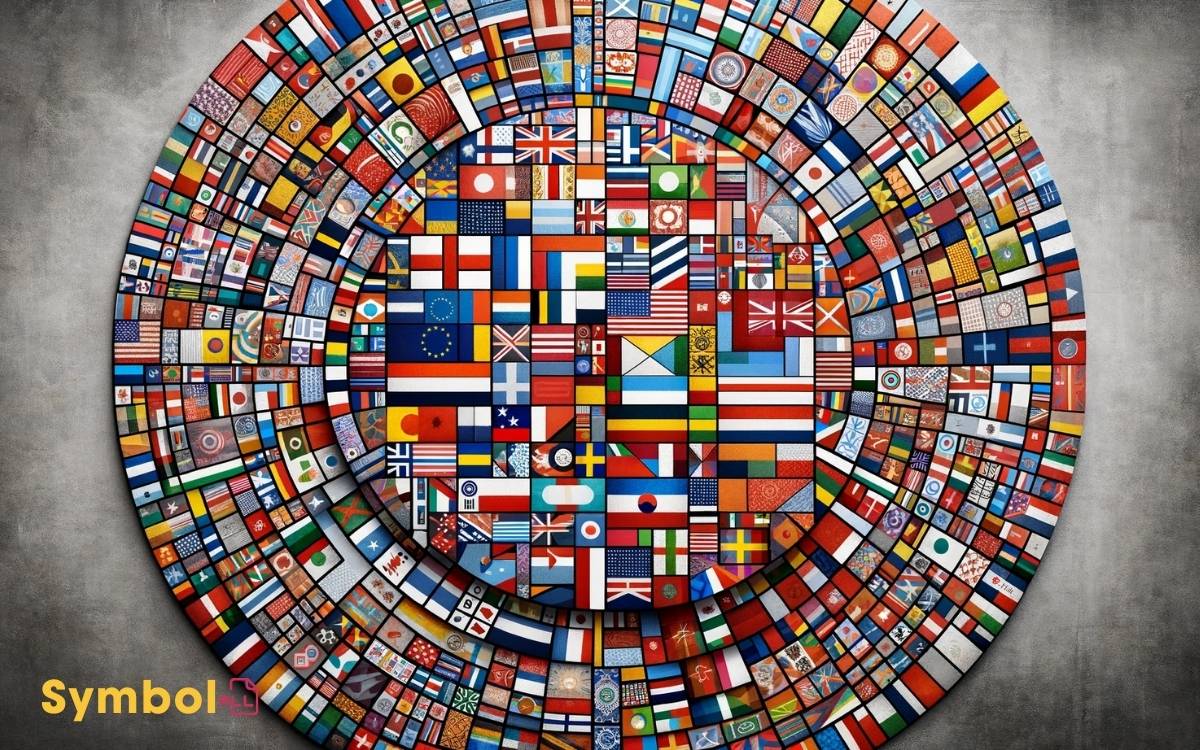Flag Symbols and Colors Meaning: A Complete List!
Flags aren’t just cloth; they’re a narrative of nationhood, with every color and symbol crafting a story.
- Red’s not merely a hue; it screams courage and a readiness for revolution.
- White transcends simplicity, embodying peace and new beginnings.
- Blue navigates deeper, symbolizing the core values of freedom and justice.
Beyond aesthetics, these colors reflect a nation’s struggles, triumphs, and aspirations. They’re keys to understanding cultural identities, historical narratives, and collective memories.
Each flag bears a unique tale, uniting citizens under a common banner. Unraveling these symbols offers insights into a nation’s soul, promising a deeper comprehension of its heritage and values.

Key Takeaway
Understanding National Flags: Colors and Symbols Explained
| Country | Flag Colors | Symbol(s) | Color Meanings | Symbol Meanings |
|---|---|---|---|---|
| United States | Red, White, Blue | 50 stars, 13 stripes | Red: Valor and bravery, White: Purity and innocence, Blue: Vigilance, perseverance, and justice | Stars: 50 states, Stripes: 13 original colonies |
| Canada | Red, White | Maple leaf | Red: Prosperity and hope, White: Peace and tranquility | Maple leaf: The natural beauty and resources of Canada |
| United Kingdom | Red, White, Blue | Crosses of St George, St Andrew, and St Patrick | Red: Courage and power, White: Peace and honesty, Blue: Loyalty, truthfulness, and justice | Crosses: Union of England, Scotland, and Ireland |
| Japan | White, Red | Red circle (‘sun-mark’) | White: Peace and honesty, Red: Hardiness, bravery, strength, and valor | Red circle: The sun (symbolizing brightness, sincerity, and warmth) |
| South Africa | Green, Yellow, Red, Black, White, Blue | Y-shape, Isivivane (pile of rocks), Protea | Green: Land, Yellow: Natural resources, Red: Blood shed for freedom, Black: People, White: European influence, Blue: Infinite possibilities | Y-shape: Convergence of diverse elements into a united path forward, Isivivane: Unity, Protea: Beauty and resilience of the nation |
| Brazil | Green, Yellow, Blue, White | Yellow diamond, blue globe with stars, motto | Green: Forests and fields, Yellow: Wealth and resources, Blue: Sky, White: Peace | Yellow diamond: Wealth, Blue globe: Sky and Brazilian states, Stars: Constellation around Rio de Janeiro, Motto: Order and Progress |
| India | Saffron, White, Green, Blue | Ashoka Chakra | Saffron: Courage and sacrifice, White: Peace and truth, Green: Faith and chivalry, Blue: The sky and the sea | Ashoka Chakra: The eternal wheel of law, righteousness, and progress |
| China | Red, Yellow | Five stars | Red: Revolution, Yellow: The five stars and the color of the Han people | Five stars: The unity of the people under the leadership of the Communist Party of China |
The Significance of Colors
Colors in flag design don’t just decorate; they communicate, embodying specific meanings and representing ideals, beliefs, or history unique to a nation or group.
- Red often symbolizes courage, revolution, or valor, reflecting a country’s struggle for independence or its people’s bravery.
- White frequently stands for peace, purity, or unity, signaling a nation’s aspirations for harmony within and beyond its borders.
- Blue can denote freedom, justice, and loyalty, embodying the principles upon which a society is founded.
- Green typically represents the land, fertility, and hope, highlighting the importance of the environment and future prosperity.
- Finally, yellow or gold symbolizes wealth, justice, and endurance, capturing a nation’s riches, both material and spiritual.
Each color, charged with meaning, weaves a complex narrative of a country’s identity and values.
Historical Origins of Flags
Understanding the symbolism behind flag colors naturally leads us to explore the roots of flag usage itself, tracing back to ancient civilizations where they served not only as military insignia but also as potent symbols of identity and unity.
The historical journey of flags reveals:
- In ancient China, flags were used to signal troops and convey messages across vast battlefields.
- Egyptian pharaohs flew banners to demonstrate their divine authority and command over their people.
- In medieval Europe, knights bore distinct flags into battles, embodying their allegiance and valor.
- Native American tribes utilized flags adorned with specific symbols to represent their cultural beliefs and kinship ties.
These examples illustrate flags’ enduring role in shaping human history, serving as a confirmation of their foundational significance in establishing and communicating collective identities.
Red: Courage and Revolution
One often finds that the color red symbolizes courage and revolution, embodying the spirit of those who dare to stand against the status quo. This vibrant hue captivates the eye, demanding attention while signaling a call to action.
Historically, red has adorned the banners of various movements, symbolizing the blood shed in pursuit of freedom or change. Its visual impact is undeniable, stirring emotions and rallying individuals around a common cause.
In the context of flags, red’s presence is powerful, conveying a nation’s or group’s readiness to face challenges, defend its values, or embrace transformative ideals.
Analyzing flags worldwide, you’ll notice red’s strategic use, not just for aesthetic appeal but as a deliberate choice to evoke solidarity, bravery, and the relentless pursuit of justice and equality.
White: Peace and Purity
You’ll find that white serves as a powerful emblem of peace and purity across various cultures, encapsulated within the folds of many national flags.
Its symbolic representations extend beyond mere aesthetics, offering insights into historical contexts where white signaled truce or new beginnings.
Understanding its historical usage sheds light on how nations have leveraged this color to embody ideals of harmony and innocence.
Symbolic Representations
In the domain of flag symbols, white stands as a universal emblem of peace and purity, reflecting a nation’s aspirations for harmony and unblemished ideals.
This color’s application in flags is profoundly symbolic, designed to resonate deeply with those who gaze upon it.
Consider how white plays a role in various flags:
- Unity: It bridges diverse elements, suggesting a collective commitment to peace.
- Sacrifice: Beyond purity, it acknowledges the sacrifices made for peace.
- New Beginnings: White heralds fresh starts, hinting at a nation’s rebirth.
- Transparency: It conveys governmental transparency and fairness.
Analyzing these symbols, you grasp the weight of white in flag design, not merely as a color but as a powerful statement of a nation’s identity and values.
Historical Usage Insights
Reflecting on the symbolic representations of white in flags offers a glimpse into how history has molded its significance as a symbol of peace and purity.
You’ll find that historically, white has been used to signify truce or surrender, a clear call for peace during times of conflict. It’s a visual representation that speaks louder than words, conveying a message of hope and reconciliation without uttering a single sound.
Additionally, its usage extends beyond the battlefield. In various cultures, white symbolizes purity and innocence, embodying ideals of cleanliness and virtue.
This dual representation—both as a harbinger of peace and a marker of purity—underscores its profound importance. It’s not just a color; it’s a powerful emblem that carries with it centuries of human aspiration and the collective desire for a harmonious existence. Its resonance transcends cultures and epochs, reminding humanity of its shared values and universal dreams. In many ways, it mirrors the capacity for transformation and renewal, much like how a symbol to change color Minecraft embodies adaptability and creative expression in the digital realm. This connection between timeless ideals and modern interpretations highlights the enduring relevance of such motifs in both physical and virtual worlds.
Blue: Freedom and Justice
As you explore the significance of blue in flag symbolism, you’ll uncover its deep roots in representing freedom and justice.
Analyzing historical blue flags reveals their role in battles for independence and civil liberties across various cultures.
Historical Blue Flags
Throughout history, blue flags have symbolized freedom and justice, embodying the ideals and struggles of nations and movements.
This hue communicates deep values, transcending mere aesthetics to represent profound principles.
Consider the following examples that illustrate blue’s historical significance:
- The Bonnie Blue Flag: First flown in 1810 by the Republic of West Florida, it became an emblem of independence against Spanish rule.
- Union Jack’s Blue Field: Symbolizes unity and democratic governance across the United Kingdom.
- The United Nations Flag: Showcases a light blue background, representing peace and cooperation among nations.
- Suffragette Banners: Often featured blue, denoting loyalty and the unyielding quest for women’s rights.
These instances highlight blue’s association with the pursuit of equity and autonomy, echoing through history as a beacon of hope and liberation.
Blue in National Flags
Building on the foundation of historical blue flags, let’s examine its significance in the context of national emblems, where blue often symbolizes freedom and justice. This color, a deep and serene hue, carries with it the weight of ideals that have shaped nations.
You’ll find that blue isn’t merely an aesthetic choice but a deliberate declaration of a country’s core values. It’s present in the flags of over a quarter of the world’s countries, each shade telling its own story of aspiration and principle.
For instance, the light blue of the United Nations flag embodies international peace and cooperation, while the darker blues of the United States and the United Kingdom flags stand for vigilance, perseverance, and justice.
Analyzing these emblems, it’s clear that blue’s inclusion is a powerful statement of a nation’s commitment to these universal ideals.
Green: Fertility and Prosperity
In various cultures, the color green symbolizes fertility and prosperity, reflecting a deep-rooted association with growth and renewal.
When you see green in a flag, it’s not merely a choice of aesthetics but a deliberate signal of a nation’s values and aspirations.
Here’s how green manifests its significance:
- Agricultural Wealth: Green often represents a country’s agricultural productivity and its connection to the earth.
- Economic Growth: It signals economic prosperity, hinting at a nation thriving in commerce and innovation.
- Natural Resources: This color stands for the abundance of natural wealth, from lush landscapes to rich biodiversity.
- Renewal and Hope: Finally, green symbolizes a commitment to environmental preservation and sustainability, evoking a sense of hope for future generations.
Understanding green’s symbolism enriches your appreciation of national identities and the stories they aim to convey.
Symbols of Unity and Identity
Just as colors like green signal a nation’s values and aspirations, symbols of unity and identity play a pivotal role in defining a country’s ethos and collective spirit.
These symbols, often deeply ingrained in a nation’s historical narrative, serve as a visual shorthand for a country’s principles, culture, and heritage.
From the olive branch signifying peace to the lion representing courage and strength, each emblem carries a wealth of meaning.
They’re not merely decorative; they encapsulate the shared experiences, struggles, and triumphs of a people.
By rallying around these symbols, citizens foster a sense of belonging and solidarity, essential for nation-building.
Understanding these symbols allows you to grasp the essence of a nation, offering insights into its past, present, and aspirations for the future.
Flags in Modern Times
Today’s flags serve as powerful symbols of identity, unity, and sovereignty, reflecting the complex narratives of nations in a rapidly globalizing world.
Their significance transcends mere representation; they embody the heritage, struggles, and aspirations of a people.
Consider the imagery evoked by:
- The stark contrast of colors symbolizing historical conflicts and peace.
- Emblematic designs pointing to cultural landmarks and natural resources.
- Stars and stripes denoting unity among diversity within a nation.
- Revolutionary symbols inspiring change and progress.
In modern times, flags aren’t just static symbols; they’re active participants in global dialogue. They flutter at international assemblies, mark territories, and rally citizens for causes, encapsulating the dynamic interplay between tradition and change.
Your understanding of a flag’s layers enriches your grasp of global narratives, making you a more informed observer of world affairs.
Cultural Interpretations of Flags
Understanding flags’ symbolic meanings offers insight into how different cultures interpret these emblems, reflecting a nation’s identity, values, and historical legacies.
For instance, the color red often symbolizes bravery, strength, and valor across various cultures, yet its significance can vary dramatically.
In China, red represents good luck and joy, while in South Africa, it recalls the struggles and sacrifices made during the fight for freedom.
Similarly, the inclusion of specific symbols, like stars or crescents, can denote important national narratives or religious affiliations, signifying unity and shared beliefs within a diverse populace.
This intricate web of meanings demonstrates that flags aren’t just pieces of fabric but powerful symbols that encapsulate the essence of a nation’s heritage, aspirations, and collective memory.
Conclusion
In the tapestry of human civilization, flags have danced in the winds of change, weaving stories of valor, purity, freedom, and prosperity.
They’re not just cloth but emblems that embody the essence of a nation, whispering tales of historical triumphs and aspirations.
As you navigate the currents of modernity, remember, these vibrant symbols and hues are more than mere decoration.
They’re the proof of cultures, a validation to unity and identity, painting the sky with the colors of our shared human journey.






